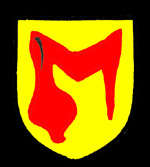The Manor of Kempston Hastingsbury

The Hastings family arms
Volume III of The Victoria County History for Bedfordshire was published in 1912 and contains histories of each of the manors in Kempston. In 1237 John le Scot, Lord of the Manor of Kempston died and, following the death of his widow and a spell in royal hands in 1254 whilst agreement on the division could be sought, the manor was divided between his three sisters. The third given to his third sister, Ada, who married Henry Hastings, became known as The Manor of Hastingsbury or Greys.
Their grandson was John, created Baron Hastings in 1295 and the family continued to hold the manor until 1389 when John Hastings died without issue. The manor then passed to his cousin and heir Reginald de Grey, Baron Grey de Ruthyn, who was also Lord of the Manor of Wrest in Silsoe.

The Grey family arms
In the middle of the 15th century the Greys enfeoffed Hastingsbury Manor to a junior branch of the family and these Greys continued as Lords of the Manor until the 16th century. The Greys seem to have been unpopular lords, The Victoria County History stating: “On Reginald’s death in 1534 his wife entered into possession and brought an action against certain tenants for the forcible rescue of cattle impounded for rents due. She declared that she was so insulted that she was constrained her dwelling-place … in 1536 the manor was taken into the king’s hands, the tenants being delighted at the change, as they were ill-treated by Reginald Grey and his wife ‘which was a very limb of the devil of hell’”.
This hellish woman had settled the manor on herself for life with a reversion to Sir William FitzWilliam, Treasurer of the Royal Household in 1534 but he had died a few weeks later. Nevertheless the Crown now recognised the family’s claim and Sir William’s sons, Thomas and Francis were given the manor. Francis alienated his half to Roger Chaloner in 1545 whose son Thomas alienated it to Thomas Leigh in 1550 who alienated it to William Bendlowes. In 1573 Thomas FitzWilliam, owner of the other half joined Bendlowes in conveying the whole manor to Humphrey FitzWilliam.
In 1619 Sir John FitzWilliam sold the manor to Sir John Wild who, before 1624, sold it to William Cater of Kempston, High Sheriff of Bedfordshire in 1630 and 1631. On Cater’s death the manor, together with its Manor House, called The Place, was devised to his youngest son Edward. Edward’s son Samuel married Anne Kendall and was High Sheriff in 1689. He died in 1704 and the manor descended to his son John, who had married a Mary Middleton in 1690.

The Cater family arms
John Cater was Member of Parliament for Bedford from 1710 to 1715 and for Bedfordshire from 1715 to 1722. He died in 1734 and his son John two years later. The manor was then inherited by Robert Kendall, Alderman of Cheap ward in London and John’s brother-in-law. On inheriting the estate he changed his name from Kendall to Cater. He was knighted in 1738 and died in the following year. The manor passed to Beckford Kendall Cater, perhaps Robert’s son. His son John married Margaret Beaumond in 1749 and the manor formed part of the settlement. John’s son John died without issue and the manor was inherited by his three sisters, May and twins Sophia and Frances. The twins married Robert Sherbourne and Rev. Oliph Leigh Spencer respectively in 1796. In 1801 the three sisters combined to sell the manor to brewer William Long, who was knighted and became Mayor of Bedford.
Around 1850 Cecil Long sold the manor to banker Talbot Barnard, who pulled The Place down, building The Bury on or near the site. In 1885 Barnard sold the manor to Walter Harter, who owned it into the 20th century. A succession of Law of Property Acts in the 1920s extinguished all manorial incidents, courts and copyhold tenure of land. This effectively abolished manors in all but name.